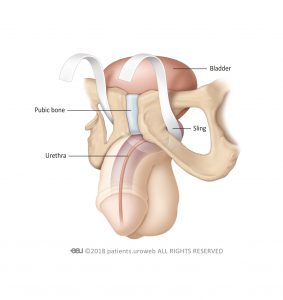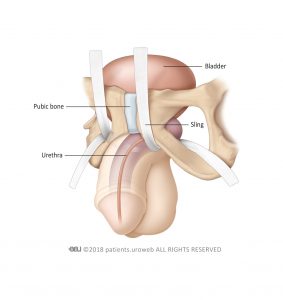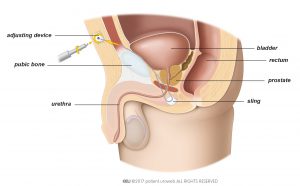A sling implant is the standard surgical treatment for treating stress incontinence in men. The procedure involves inserting a mesh strap, called a sling, under the urethra to support it. The sling is made of synthetic material and helps the urethra stand up to pressure when you do a sudden movement or action, such as a cough or sneeze. The sling material remains permanently inside your body, so it is not absorbed over time.
When correctly placed, the sling lightly compresses the urethra to slightly close it, helping to prevent the urethra from leaking urine unexpectedly, as can happen with stress incontinence.
Your doctor will discuss in detail how they would plan to insert the sling. This involves having an incision between your scrotum and anus. There are different types of slings and different ways the operation can be carried out. The diagrams below show the different types of slings.
In two-arm slings, the ends of the sling are put in position on both sides of the urethra, shaping the sling like a hammock. Then, the ends of the sling are attached to tissue either just above the pubic bone, or around the groin.
In four-arm slings, the ends of the sling are put in position on both sides of the urethra, shaping the sling like a hammock. Then, two ends of the sling are attached to the groin, while the other two are attached to tissue around the pubic bone.
For adjustable slings, the technique may include additional incisions to insert an adjusting device in the body, which allows adjustable support of the urethra.
There is limited evidence that adjustable male slings can cure or improve stress incontinence.
The type of sling recommended to you will depend on your individual circumstances, such as those slings offered by your hospital or in your country, and which slings your doctor has experience with using. Your doctor will discuss their recommendation and the sling offered to you, as well as the possible side effects.




